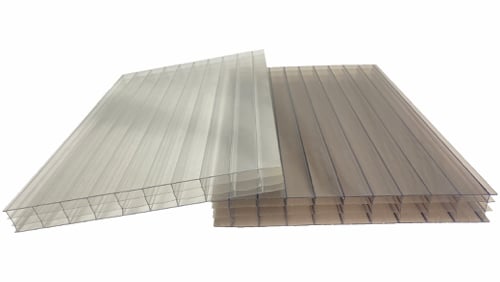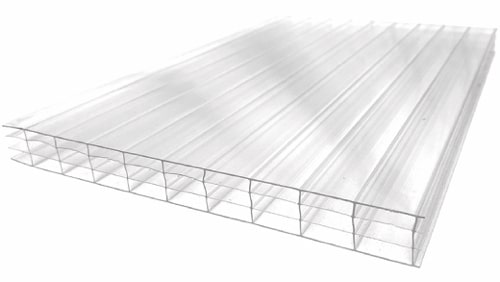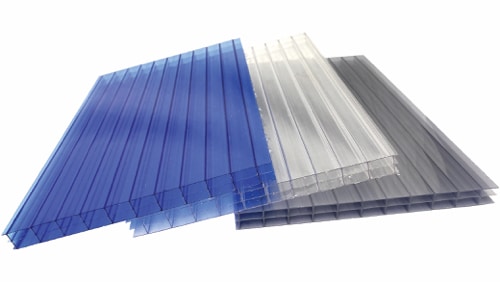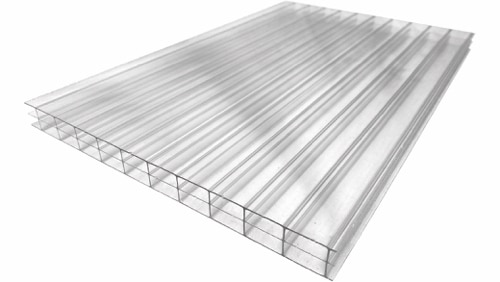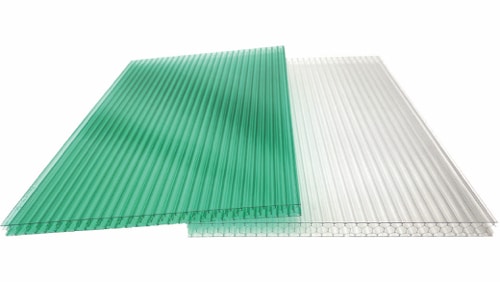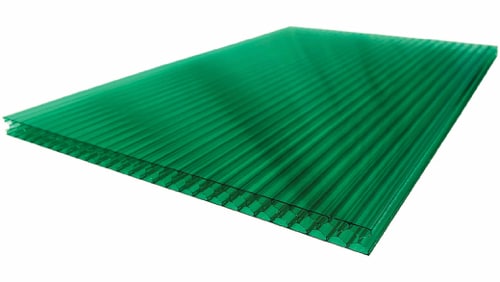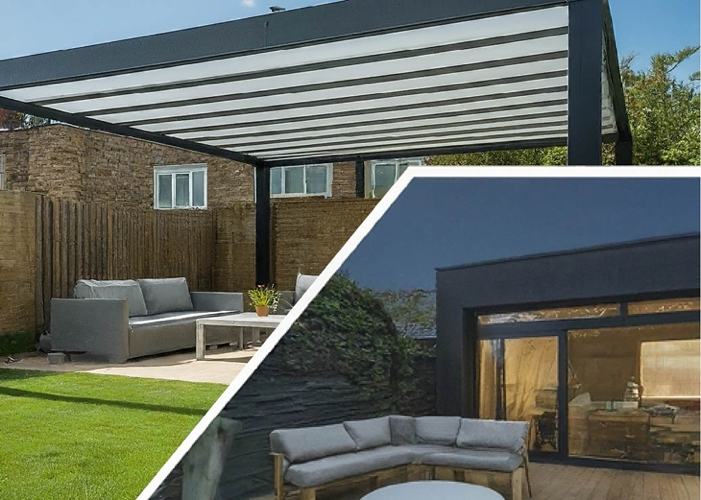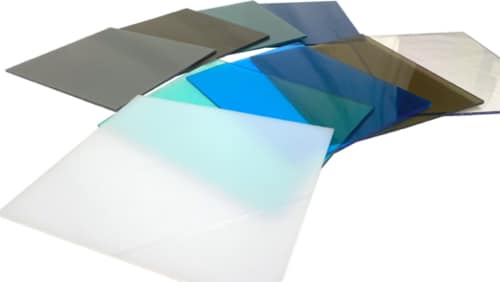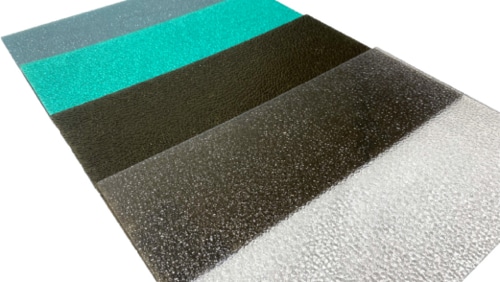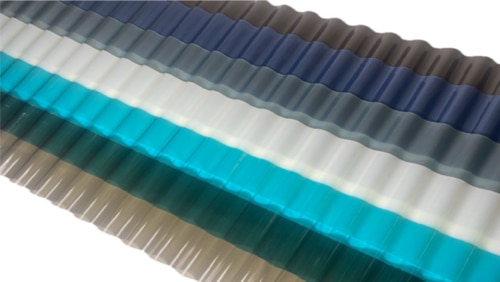History of Polycarbonate
Polycarbonate roofing has gained popularity in recent years, but many people may still be unfamiliar with it. So, what is polycarbonate roofing? Prior to the discovery of polycarbonate material and its use, roofing materials usually comprise of wood, composite, metal, clay/brick, and for outdoor sunlight penetration requirements, you have a choice between glass or acrylic, as plastics such as PVC and Fiberglass (FRP) does not allow enough visible light to pass through.- It wasn’t until the 1950s was polycarbonate commercialized, and only until 1970 were it able to be produced glass clear instead of the brownish tint it carried at the beginning.
Although acrylic sheets were commercially produced more than 30 years earlier than polycarbonate sheets and used as “safety glass”, they still posed a threat as acrylic cracks easily and breaks into shards when damaged.
What is polycarbonate roofing?
What is polycarbonate roofing? Polycarbonate sheets can be described as acrylic on steroids. Polycarbonate possesses all of the physical properties of Acrylic but is 10 times stronger and does not shatter, which makes it significantly safer as a glazing material for commercial use. These properties alone make polycarbonate panels perfect for roofing and construction purposes, offering superior strength, durability, and safety compared to traditional materials like glass or acrylic.
Advantages of Polycarbonate Roofing
Durability:
Polycarbonate roofing sheets are incredibly durable and can withstand even the harshest weather conditions, making them perfect for the intense heat of Western Australia’s summers, heavy rains, and strong winds. The material is both tough and flexible, ensuring long-lasting performance. Additionally, polycarbonate sheets are resistant to UV rays, which minimizes discoloration over time.
(Read more: Polycarbonate Heat Resistance: Part 2 – Applications & Solutions)
Versatility :
Polycarbonate roofing is available in a variety of sheet profiles, including corrugated, Greca, and Trimdek, allowing you to select the best option for your specific requirements. These sheets are also lightweight, making them easier to handle and install compared to traditional roofing materials.
(Read more: Handling, Storage & Cleaning Polycarbonate Sheets)
Energy Efficiency :
One of the most notable features of polycarbonate sheets is their ability to transmit light. They allow ample natural light to filter through while providing shelter to the area below, reducing the need for artificial lighting and helping you save on energy costs. Moreover, polycarbonate roofing offers excellent insulation properties, keeping you cooler in summer and warmer in winter.
(Read more: Translucent Roofing Sheets: Energy Efficiency and Cost Savings)
Low Maintenance :
Maintaining polycarbonate roofing is relatively simple. Cleaning the roof sheets with warm, soapy water is usually sufficient to keep them in good condition. It is also recommended to conduct periodic inspections to check for debris and damage.
Aesthetic Appeal : Polycarbonate roofing can enhance the look of any roof with its modern and sleek appearance. It is available in a range of profiles and colors, allowing you to choose the perfect style to complement your building’s aesthetic.
Disadvantages of Polycarbonate Roofing
Polycarbonate Roofing Requires Special Care
Polycarbonate roofing and materials are vulnerable to scratches, which poses a unique challenge when it comes to cleaning. Regular cleaning solutions containing abrasives, alkaline, or solvents can damage the surface of polycarbonate, causing it to peel or become thinner over time. This can significantly reduce the lifespan and durability of the material.(Read more: How to Clean Polycarbonate Roof)
High In Cost
One potential drawback of using polycarbonate sheets for roofing is the relatively higher upfront cost compared to some alternative materials. The initial investment required for polycarbonate sheets may present a financial challenge for some projects.
How to Choose the Right Polycarbonate Sheet?
Polycarbonate Profile
Polycarbonate sheets are available in various profiles to cater to different roofing and cladding needs. Solid flat and embossed sheets provide a smooth or textured finish, while corrugated profiles like ROMA, GRECA, TRIMDEK, MINI, JEMPAL, PUMA, and JAGUAR offer strength and durability. Multiwall hollow sheets, such as double-wall, triple-wall, four-wall, and honeycomb, deliver excellent insulation and light diffusion. With this diverse range of polycarbonate profiles, you can find the ideal solution for your project, combining functionality and aesthetics.
Polycarbonate Size
When choosing the size of a polycarbonate sheet for your project, consider the following factors: thickness, length, width, and weight. Thickness is the most crucial factor, as it determines the sheet’s strength and performance. Polycarbonate sheets come in various thicknesses, ranging from 0.4mm to 15mm or more, depending on the profile and manufacturer. For commercial roofing and skylights, especially in areas with heavy rainfall, a 6mm solid flat sheet thickness or above is recommended.
For warehouse skylights or wall cladding, corrugated polycarbonate sheets with thicknesses ranging from 0.8mm to 1.5mm are often the best choice.
Length is the second most important factor due to polycarbonate’s high coefficient of thermal expansion. Allow for adequate expansion gaps and use appropriate fastening methods to accommodate thermal movement. Consider the width of the sheet, which is typically determined by the manufacturer’s standard sizes, and choose a width suitable for your project’s dimensions. Lastly, factor in the weight of the polycarbonate sheets, as this can impact the ease of handling and installation. By carefully considering these factors, you can select the most appropriate size of polycarbonate sheet for your specific application, ensuring a successful and cost-effective project.
(Read more: Size of Polycarbonate Sheet Selection : How to Choose correctly)
Polycarbonate Color
When choosing the color of polycarbonate sheets for your roofing project, consider both aesthetics and functional properties, such as heat reduction, IR block, and light penetration. If using polycarbonate sheets with metal roofing, ensure the colors match or complement each other.
VULCAN offers a wide variety of polycarbonate sheet colors, including transparent, translucent, haze, metallic, soft diffused lighting, and pearl reflection. To select the perfect color, compare polycarbonate color sample cards to the RAL color codes and samples of the connecting roof sheet. Keep in mind that the perceived color may not always match its designated color code.
Cross-check between the color codes and the connecting roof sheet before finalizing production to ensure a seamless and visually appealing result. With careful consideration of color terminology and properties, you can choose the ideal polycarbonate sheet color for your roofing project.
(Read more: Polycarbonate Roof Colors)
Polycarbonate Roof Installation
Installing polycarbonate roofing sheets is a straightforward process that requires careful planning and attention to detail. Begin by selecting the appropriate polycarbonate profile for your project, such as corrugated or solid flat sheets. Ensure that you have all the necessary accessories and tools before starting the installation.
When installing polycarbonate sheets, always prioritize safety by using proper equipment and following local building codes. Ensure that the sheets are installed with the UV-protected side facing up and at an adequate pitch to allow for proper drainage and weather resistance.
Secure the sheets using the appropriate fasteners, starting from the lower edge and working your way up. Apply sealing tape or closure strips where needed to prevent leaks and ensure a weatherproof installation.
By following these general guidelines and the specific instructions provided by the manufacturer, you can successfully install polycarbonate roofing sheets for your project.
If you are still unclear about what a polycarbonate roofing is, please contact us via phone or email us at [email protected] for more information.
Related articles:
How to Cut Polycarbonate Sheets: Tips, Tools, and Techniques
Polycarbonate Properties | A Must-Read PC Material Guide
Polycarbonate Roofing Design : When Functionality Meets Style

